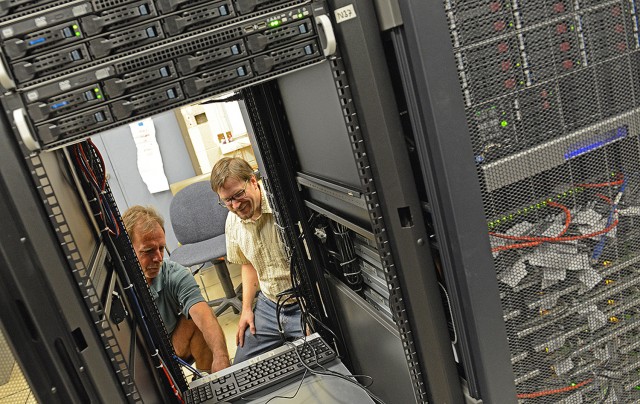Wesleyan’s New Computing Cluster Can Process Computations 50X Faster

While technology at Wesleyan is growing by leaps and bounds, the computational capacity is growing by gigaFLOPS and now, teraFLOPS.
Not to be confused with the prehistoric pterodactyl’s beach footwear, a teraFLOP is a term used in high-performance computing to quantify the rate at which computer systems can perform arithmetic operations. TeraFLOPs can perform one trillion operations per second (S), and for scientists at Wesleyan, this means calculations can be done up to 50 times faster with the new computing cluster, installed during the summer 2013.

“The new cluster has been revolutionary in my own work,” said Francis Starr, professor of physics. “I used to run calculations that would take a month or even a year to compute, and my patience would run out. Now, I can get results in two or three days.”
In 2006, Wesleyan’s computing cluster came in around 0.5 teraflops. In the 2010 at 1.5 teraflops, and the newest cluster has a theoretical capacity of 25 to 75 teraflops, depending on the application.
“By way of comparison, my Mac laptop comes in around 0.02 teraflops, so I would need 3,500 laptops to achieve the same compute power! I think I will need a bigger backpack,” Starr said.
The new technology also is “green.” While the new machine is 100 times more powerful than the 2006 cluster, it requires half the the electrical power to operate and less cooling power to run the hardware.
The new cluster is currently used by faculty and students in chemistry, computer science, physics, biology, the social sciences and the Quantitative Analysis Center. Henk Meij, unix systems group manager and a senior consultant for the QAC, manages the facility’s operation and offers support and maintenance for any software issues. He also offers training and teaches faculty and students how to submit jobs to the scheduling system.
“Anyone on campus who needs a fast computation, ITS offers this tremendous resource which can be very beneficial to your research,” Meij said. “We can now solve real world problems in a matter of days.”
The newest cluster cost $125,000, and is the third facility funded through two National Science Foundation awards. The grant principal investigators included Starr; David Beveridge, the Joshua Boger University Professor of the Sciences and Mathematics, professor of chemistry; and Michael Weir, professor of biology and director of the Hughes Program in the Life Sciences. Additional support came from the Natural Sciences and Mathematics Division and the Quantitative Analysis Center.
The origin of the tremendous increase in computer power with reduction of electrical consumption comes by the adoption of GPU (graphical processing units) technology.
“Lots of people love video games, so over the years, manufacturers have developed specialized hardware (GPUs) to render high-resolution graphics very rapidly,” Starr explained. “A few years back, scientists realized we could use these same specialized devices to speed up our scientific calculations, so we’re taking advantage of this.”
To compare, the typical CPU in a desktop or laptop computer likely uses four or eight complex cores for calculation. One GPU in the new cluster has nearly 2,500 cores, for total of 50,000 GPU cores. The cores are much simpler than those in a CPU, but the aggregate of these cores is tremendously powerful, Starr explained. That is roughly the same as the rest of campus computers combined.
To match the increase in computing power, the new cluster also offers an additional 50 terabytes of disk space for a total of 100 terabytes of data storage.
“Going back to analogies, this is the storage capacity that you would have in around 3,200 iPhones,” Starr said. “Again, I would need much bigger pockets.”
For more information on the cluster, or to get set up, e-mail Meij or Starr.

